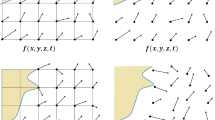Abstract
The rate of diffusion of a cloud depends on cloud dimensions. As the cloud enlarges, larger eddies come into play and the rate of diffusion increases. The turbulent diffusion process is scale-dependent. The gradient-transfer theory (K-theory) is only appropriate when the dimensions of the dispersed material are much larger than the size of the turbulent eddies. Introduction of a spectral turbulent diffusivity function (STD) makes it possible to treat the diffusive transport in a Eulerian system, with diffusivity effectively dependent on the actual size of the concentration distribution. The basic innovation is that diffusion is treated in the Fourier space and the diffusion coefficient is dependent on the wave number of the Fourier components of the concentration distribution. It is shown that the concept of the wave-number-dependent diffusivity leads to a non-local flux-gradient relation.
Similar content being viewed by others
References
Batchelor, G. K.: 1953, The Theory of Homogeneous Turbulence, Cambridge University Press, pp.197.
Batchelor, G. K. and Townsend, A. A.: 1956, ‘Turbulent diffusion’, in Surveys in Mechanics, ed. G. K. Batchelor and R. M. Davies, Cambridge University Press, 352–399.
Berkowicz, R. and Prahm, L. P.: 1979, ‘Generalization of K-theory for turbulent diffusion. Part I. Spectral turbulent diffusivity concept’, J.Appl.Met. 18, 266–272.
Berkowicz, R. and Prahm, L. P.: 1980, ‘On the spectral turbulent diffusivity theory for homogeneous turbulence’, J.Fluid Mech. 100, 433–448.
Berkowicz, R. and Prahm, L. P.: 1984, ‘Spectral representation of the vertical structure of turbulence in the convective boundary layer’, Quart.J.Roy.Meteorol.Soc. 110 (in press).
Berkowicz, R., Prahm, L. P. and Louis, J. F.: 1979, ‘Global 2-D spectral dispersion model’, WMO Rep. no. 538, Proc. WMO Symp. on the Long-Range Transport of Pollutants and its Relation to General Circulation Including Stratospheric-Tropospheric Exchange Processes, Sofia.
Bærentsen, J. H. and Berkowicz, R.: 1984, ‘Monte Carlo simulation of plume dispersion in the convective boundary layer’, Atm. Env. 18, (in press).
Christensen, O. and Prahm, L. P.: 1976, ‘A pseudospectral model for dispersion of atmospheric pollutants’, J.Appl.Meteorol. 15, 1284–1294.
Enger, L.: 1983, ‘Numerical boundary layer modeling with application to diffusion’, A Two Dimensional Higher Order Closure Model, Department of Meteorology, University of Uppsala, Report No. 70-71, pp.54.
Heisenberg, W.: 1948, ‘Zur statistischen Theorie der Turbulenz’ Z.Phys. 124, 628–657.
Kraichnan, R. H.: 1959, ‘The structure of isotropic turbulence at very high Reynolds numbers’, J.Fluid Mech. 5, 497–543.
Lamb, R. G.: 1978, ‘A numerical simulation of dispersion from an elevated point source in the convective planetary boundary layer’, Atm.Env. 12, 1297–1304.
Leslie, D. C.: 1973, Developments in the Theory of Turbulence, Clarendon Press, pp.368.
Lewellen, W. S. and Teske, M. E.: 1976, ‘Second-order closure modeling of diffusion in the atmospheric boundary layer’, Boundary-Layer Meteorol. 10, 69–90.
Markee, E. H.: 1963, ‘On the relationships of range to standard deviation of wind fluctuations’, Mon.Weath.Rev. 91, 83–87.
Monin, A. S.: 1955, ‘Equation of turbulent diffusion’, Dokl.Akad.Nauk SSSR 105, 256–259.
Monin, A. S.: 1956, ‘Horizontal mixing in the atmosphere’, Isv.Akad.Nauk SSSR, Ser.Geofiz. 3. 327–345.
Monin, A. S. and Yaglom, A. M.: 1965, Statistical Fluid Mechanics of Turbulence, Part I. Washington, Trans-Joint Publication Research Service, pp.769.
Pasquill, F.: 1974, Atmospheric Diffusion, 2nd edition, Wiley, pp.425.
Pedersen, P. N. and Kristensen, H. S.: 1982, Experimental Investigation of Diffusion of Particles in Turbulent Flows, AFM 82-04, Department of Fluid Mechanics, Technical University of Denmark, pp.46 (Danish)
Pedersen, P. N., Tambo, M. and Kristensen, H. S.: 1984, Concentration Measurements using a Laser Doppler Anemometer, AFM 81-8, Department of Fluid Mechanics, Technical University of Denmark, pp.23.
Phythian, R. and Curtis, W. D.: 1978, ‘The effective long-time diffusivity for a passive scalar in a Gaussian model fluid flow’, J.Fluid Mech. 89, 241–250.
Prahm, L. P. and Christensen, O.: 1977, ‘Long-range transport of pollutants simulated by the 2-D pseudospectral dispersion model’, J.Appl. Met. 16. 896–910.
Prahm, L. P., Berkowicz, R. and Christensen, O.: 1979, ‘Generalization of K-theory for turbulent diffusion. Part II. Spectral diffusivity model for plume dispersion’, J.Appl.Met. 18, 273–282.
Prandtl, L.: 1925, ‘Bericht über Untersuchungen zur ausgebildeten Turbulentz’, Z.Angew.Math.Mech. 5, 136–139.
Roberts, P. H.: 1961, ‘Analytical theory of turbulent diffusion’, J.Fluid Mech. 11, 257–283.
Schmidt, W.: 1925, ‘Der Massenaustausch in freier Luft und Verwandte Erscheinungen’, Probleme der Kosmischen Physic, Hamburg, Verlag Von Henri Grand, pp.176.
Schönfeld, J. C.: 1962, ‘Integral diffusivity’, J.Geophys.Res. 67, 3187–3199.
Taylor, G. I.: 1921, ‘Diffusion by continuous movements’, Proc. London Math.Soc. 20 (Ser. 2), 196–211.
Willis, G. E. and Deardorff, J. W.: 1976, ‘A laboratory model of diffusion into the convective planetary boundary layer’, Quart.J.Roy.Meteorol.Soc. 102, 427–445.
Zlatev, Z., Berkowicz, R. and Prahm, L. P.: 1982, ‘Choice of time-integration scheme in pseudospectral algorithm for advection equations’, Numerical Methods for Fluid Dynamics, eds. K. W. Morton and M. J. Baines, Academic Press, London, 303–321.
Zlatev, Z., Berkowicz, R. and Prahm, L. P.: 1983, ‘Numerical treatment of the advection-diffusion equation. Part 6, Special treatment of the diffusion terms’, MST LUFT — A72, Air Pollution Laboratory, National Agency of Environmental Protection, Risø National Laboratory, DK-4000 Roskilde, Denmark, pp.35.
Zlatev, Z., Berkowicz, R. and Prahm, L. P.: 1983, ‘Testing subroutines solving advection-diffusion equations in atmospheric environments’, Computer and Fluids, 11, 13–38.
Author information
Authors and Affiliations
Rights and permissions
About this article
Cite this article
Berkowicz, R. Spectral methods for atmospheric diffusion modeling. Boundary-Layer Meteorol 30, 201–219 (1984). https://doi.org/10.1007/BF00121955
Issue Date:
DOI: https://doi.org/10.1007/BF00121955




